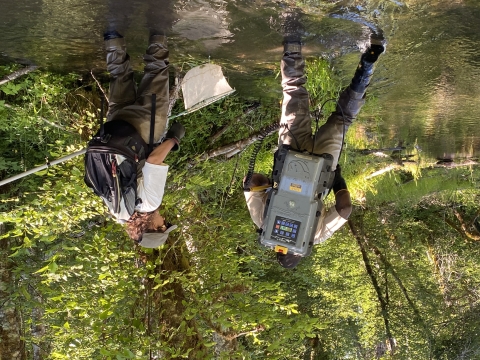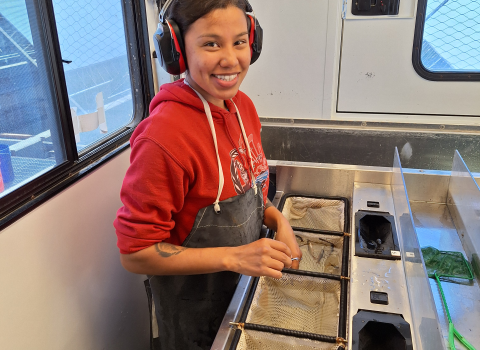It is a perfect Pacific Northwest summer day at Tyee Springs, the unique water source for Carson National Fish Hatchery (NFH). The 220 acres of hatchery property, on which the springs are located, are surrounded by Washington’s Gifford Pinchot National Forest. Today is one of those not too hot, not too cold, just right kind of days. Tyee Springs bubbles and gurgles out of the ground at a brisk 45 degrees Fahrenheit. The forest canopy lets in some dappled sunlight while the springs act as nature’s air-conditioner. Birds sing, insects buzz, and we spot a frog. Into this seemingly pristine setting swims the non-native, invasive invader: the brook trout.
To be more exact, brook trout were introduced as a prized angling fish throughout the West in the mid-19th century. Carson NFH even raised and released brook trout from around 1940 until the early 1960s. Today we realize the dangers and unanticipated consequences of moving plants and animals from their natural habitats to new areas. These non-native, invasive species invasive species
An invasive species is any plant or animal that has spread or been introduced into a new area where they are, or could, cause harm to the environment, economy, or human, animal, or plant health. Their unwelcome presence can destroy ecosystems and cost millions of dollars.
Learn more about invasive species introduced into new areas do not have natural predators. They tend to outcompete the native species and take over the habitat often leading to the demise of the native species.
Today, best management practices for Carson NFH calls for a “fishless” water source. The introduced brook trout in Tyee Springs pose a risk to the hatchery and Wind River downstream; as well as other drainages where Carson NFH sends salmon. The non-native brook trout in Tyee Springs, located just upstream of the hatchery, can be a source of devastating sickness such as bacterial kidney disease and whirling disease that can be transferred to the hatchery fish as well as downstream into endangered fish populations on the Wind River.
To rid the springs of the non-native brook trout, biologists Jennifer Poirier and Brian Davis from the Columbia River Fish and Wildlife Conservation Office have a secret weapon; male brook trout with YY chromosomes! It is called the Trojan Y Chromosome Technique. The goal of this program is to eliminate the non-native brook trout through breeding. YY brook trout come from cross breeding normal males (XY) with “feminized” males that have been treated with hormones.
This summer represents year three of the ongoing project. Over the past several years more than 5,000 brook trout have been removed from the springs and approximately 4,500 YY male brook trout have been stocked. Without getting too deep into the science, here’s the idea: The YY chromosome males can only produce male offspring. As the YY brook trout breed with the females, each cycle only produces more males. With the number of breeding females decreasing each cycle, it will eventually lead to the end of the brook trout population in Tyee Springs. Poirier and Davis calculate the brook trout population will collapse in approximately 10 years.
I’m like the eager little sister tagging along with the cool kids (the biologists and their crew) as they trudge through dense brush and muddy sinks (where my too big wader boots are almost pulled off) on our way to the beautiful work site: Tyee Springs.
Our first task today is to check the gill nets set the previous day. This is the last day of the season for removing the brook trout. The goal is to capture as many of the brook trout as we can by checking the gill nets and then electro-shocking using electro-backpacks and an electro-fishing barge. As this season has progressed, the crew is catching fewer and fewer brook trout each day. This is a good thing because it means the previous eradication efforts have been successful. We removed 10 fish from the gill net. After noticing one of the fish had a flattened head like something had chewed on it, there was some speculation as to just how many of the netted fish were eaten by the resident otters. I’m rooting for the otters.
Half the crew used the electro-barge to stun the brook trout as they worked their way through the springs toward the hatchery. How it works is one person pushes the electrically charged barge while the two other people scoop up the stunned fish with hand-held nets. Meanwhile the other crew members used a backpack-shocker to remove more brook trout. In groups of two, one person wears the backpack and walks and shocks while the other is close at hand, skillfully scooping up the stunned fish with their hand-held nets. Rubber gloves and no holes in the waders is the key to not getting shocked! On this day the electro-fishing barge crew and backpack-shocker crews removed 136 brook trout, bringing the total to 1,833 brook trout removed over 12 visits to Tyee Springs this season.
All brook trout removed from Tyee Springs are “worked up” by recording the length, sex and other biological information of each fish. The fish are then sent to the Oregon Zoo to become tasty snacks for their captive otters.
All in all, it’s not a bad day at the “office” helping our freshwater ecosystem by removing one non-native fish at a time.






